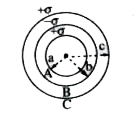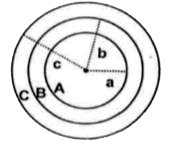Three concentric metallic spherical shell A,B and C or radii a,b and c(a<b<c) have surface charge densities −σ,+σand−σ. Respectively. The potential of shel A is :
(σ/ε0)(a+b−c)
(σ/ε0)(a−b+c)
(σ/ε0)(a−b−c)
none
The correct Answer is:C
To find the potential at shell A, we will follow these steps:
Step 1: Understanding the Configuration
We have three concentric metallic spherical shells A, B, and C with radii a, b, and c respectively, where a<b<c. The surface charge densities are given as follows:
- Shell A: −σ
- Shell B: +σ
- Shell C: −σ
Step 2: Formula for Potential
The potential V at a point due to a charged shell can be calculated using the formula:
V=14πϵ0Qr
where Q is the charge on the shell and r is the distance from the center to the point where the potential is being calculated.
Step 3: Calculate Charges on the Shells
The charge Q on each shell can be calculated using the formula:
Q=σ×A
where A is the surface area of the shell. The surface area of a sphere is given by 4πr2.
- Charge on shell A:
QA=−σ×4πa2=−4πσa2
- Charge on shell B:
QB=σ×4πb2=4πσb2
- Charge on shell C:
QC=−σ×4πc2=−4πσc2
Step 4: Calculate Potential at Shell A
The potential at shell A due to itself, shell B, and shell C can be expressed as:
VA=VA+VB+VC
Since the potential due to a shell at its own surface is constant and equal to the potential outside it, we have:
VA=14πϵ0(QA⋅1a+QB⋅1a+QC⋅1a)
Substituting the charges:
VA=14πϵ0(−4πσa2⋅1a+4πσb2⋅1a−4πσc2⋅1a)
Step 5: Simplifying the Expression
Now, simplifying the expression:
VA=14πϵ0⋅−4πσa2+4πσb2−4πσc2a
=−σa+σb−σcϵ0
=σϵ0(−a+b−c)
Final Answer
Thus, the potential at shell A is:
VA=σϵ0(b−a−c)
We have three concentric metallic spherical shells A, B, and C with radii a, b, and c respectively, where a<b<c. The surface charge densities are given as follows:
- Shell A: −σ
- Shell B: +σ
- Shell C: −σ
The potential V at a point due to a charged shell can be calculated using the formula:
V=14πϵ0Qr
where Q is the charge on the shell and r is the distance from the center to the point where the potential is being calculated.
The charge Q on each shell can be calculated using the formula:
Q=σ×A
where A is the surface area of the shell. The surface area of a sphere is given by 4πr2.
QA=−σ×4πa2=−4πσa2
- Charge on shell B:
QB=σ×4πb2=4πσb2
- Charge on shell C:
QC=−σ×4πc2=−4πσc2
The potential at shell A due to itself, shell B, and shell C can be expressed as:
VA=VA+VB+VC
Since the potential due to a shell at its own surface is constant and equal to the potential outside it, we have:
VA=14πϵ0(QA⋅1a+QB⋅1a+QC⋅1a)
Substituting the charges:
VA=14πϵ0(−4πσa2⋅1a+4πσb2⋅1a−4πσc2⋅1a)
Now, simplifying the expression:
VA=14πϵ0⋅−4πσa2+4πσb2−4πσc2a
=−σa+σb−σcϵ0
=σϵ0(−a+b−c)
Thus, the potential at shell A is:
VA=σϵ0(b−a−c)
Topper's Solved these Questions
- ELECTROSTATICSBOOK - AAKASH SERIESCHAPTER - ELECTROSTATICSEXERCISE - ADDITIONAL PRACTICE EXERCISE (LEVEL -II LECTURE SHEET (ADVANCED) MORE THAN ONE CORRECT ANSWER TYPE QUESTIONS)
4 Videos
- ELECTROSTATICSBOOK - AAKASH SERIESCHAPTER - ELECTROSTATICSEXERCISE - ADDITIONAL PRACTICE EXERCISE (LEVEL -II LECTURE SHEET (ADVANCED) LINKED COMPREHENSION TYPE QUESTIONS)
2 Videos
- ELECTROSTATICSBOOK - AAKASH SERIESCHAPTER - ELECTROSTATICSEXERCISE - ADDITIONAL PRACTICE EXERCISE (LEVEL - I (MAIN) (STRAIGHT OBJECTIVE TYPE QUESTIONS)
24 Videos
- ELECTROMAGNETICSBOOK - AAKASH SERIESCHAPTER - ELECTROMAGNETICSEXERCISE - ADDITIONAL EXERCISE
13 Videos
- ELEMENTS OF VECTORSBOOK - AAKASH SERIESCHAPTER - ELEMENTS OF VECTORSEXERCISE - QUESTIONS FOR DESCRIPTIVE ANSWERS
10 Videos
Similar Questions
Three concentric metallic spherical shells A,B and C of radii a,b and c(a<b<c) have surface charge densities +σ,−σand +σ respectively ,the potential of shell B is
View SolutionThree concentric spherical metallic shells A,B and C of radii a,b and c (a<b<c) have surface charge densities σ,−σandσ respectively.
If the potential of shell B is VB=σ∈0(anb−b+c) and the potential of shell C is VC=σ∈0(anc−bnc+c) then n is .
View Solution
Knowledge Check
Three concentric spherical shells have radii a,b and c(a<b<c) and have surface charge densities σ,−sigam and σ respectively. If VA,VB and VC denote the potentials of the three shells, then for c=a+b, we have
AVC=VB=VABVC=VA≠VBCVC=VB≠VADVC≠VB≠VA
Three concentric spherical metallic spheres A,B and C of radii a,b and c(a<b<c) have surface charge densities σ,−σ and σ respectively.
View SolutionThree concentric spherical metal shells A.B.C of radii a,b,c(c>b>a) have surface charge density +σ,−σand+σ respectively. The potential of the middle shell is σε0 times

View SolutionThree concentric spherical metallic shells A,B,andC of radii a,b,andc(a<b<c) have surface charge densities σ,−σ and σ, respectively.
If VA,VB and VC are potential of shells A, B and C, respectively, match the columns
Column AColumn Ba.VAi.σε0[a2−b2+c2c]b.VBii.σ2ε0[a2b−b+c]c.VCiii.σε0[a−b+c]
View SolutionThree concentric spherical shells have radii a,b and c(a<b<c) and have surface charge densities σ,−σ and σ respectively. If VA,VB and VC denote the potentials of the three shells, then for c=q+b, we have
View SolutionThree concentric charged metallic spherical shells A, B and C have radii a,b and c, charge densities σ,−σ and σ and potentials VA,VB and VC respectively. Then which of the following relations is correct?

View SolutionThere are three concentric thin spheres of radius a,b,c(a>b>c). The total surface charge densities on their surfaces are σ,−σ,σ respectively. The magnitude of the electric field at r (distance from centre) such that a>r>b is:
View SolutionA charge Q is distributed over three concentric spherical shells of radii a, b, c (a< b < c) such that their surface charge densities are equal to one another.
The total potential at a point at distance r from their common centre, where r<a, would be :
View Solution
